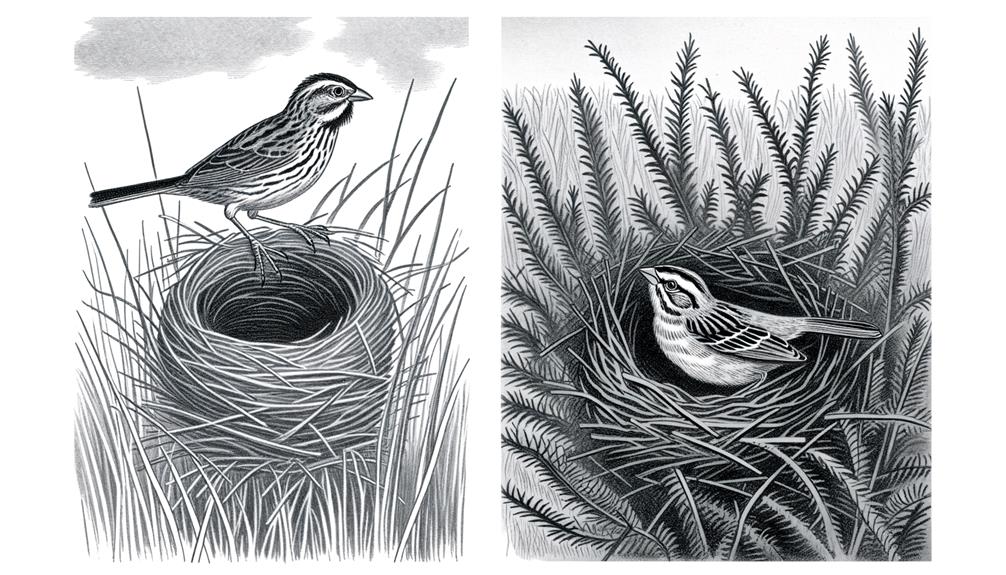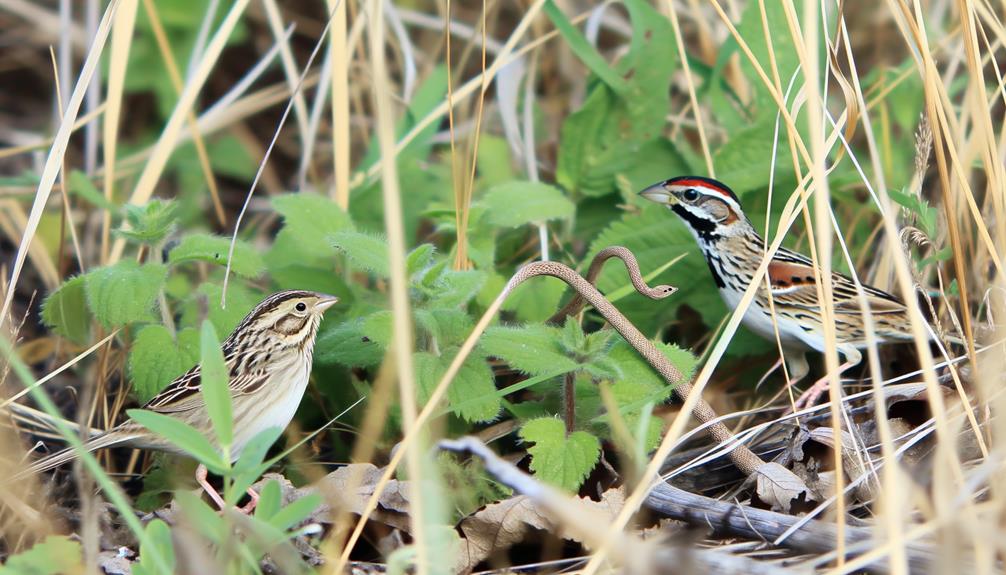Grasshopper Sparrow vs Lincoln’s Sparrow: 7 Key Differences
Grasshopper Sparrows and Lincoln's Sparrows display notable distinctions. Grasshopper Sparrows have buffy, pale coloration and average 12 cm in length, while Lincoln's Sparrows feature detailed streaking and a richer brown hue, measuring around 14 cm.
Grasshopper Sparrows inhabit open grasslands and nest in bare ground patches, whereas Lincoln's Sparrows prefer dense, moist shrublands. Their diets differ, with Grasshopper Sparrows primarily consuming insects and Lincoln's Sparrows foraging on seeds and invertebrates.
Grasshopper Sparrows produce insect-like trills, contrasting with Lincoln's Sparrows' melodious warbles. Migration patterns indicate Grasshopper Sparrows engage in short-distance migrations, while Lincoln's Sparrows undertake longer journeys for breeding and wintering.

Key Takeaways
- Grasshopper Sparrows have buffy, pale coloration and a central crown stripe, while Lincoln's Sparrows are richly streaked with a brownish hue.
- Grasshopper Sparrows inhabit grasslands; Lincoln's Sparrows prefer dense shrublands and wet meadows.
- Grasshopper Sparrows produce high-pitched, insect-like trills; Lincoln's Sparrows sing intricate, melodious notes.
- Grasshopper Sparrows nest in open grasslands; Lincoln's Sparrows build nests in moist, dense vegetation.
- Grasshopper Sparrows mainly forage on insects, whereas Lincoln's Sparrows have a varied diet of seeds and invertebrates.
Physical Appearance

Regarding physical appearance, the Grasshopper Sparrow displays a mainly buffy and pale coloration, while the Lincoln's Sparrow features more detailed streaking and a richer, brownish hue. The Grasshopper Sparrow's back is adorned with subtle, dark streaks, and its pale underparts make it less conspicuous in grassland habitats. Its crown is marked by a distinct central stripe.
Conversely, the Lincoln's Sparrow showcases intricate, fine streaking over its chest and flanks, providing a more textured look. Its grayish face is accentuated by a delicate eye-ring and a buffy mustache stripe, creating a striking contrast. Measurements reveal that the Grasshopper Sparrow averages 12 cm in length, whereas the Lincoln's Sparrow typically measures around 14 cm, highlighting slight morphological differences.
Habitat Preferences
The Grasshopper Sparrow mainly inhabits grasslands and open fields. It leverages sparse vegetation for nesting and foraging.
In contrast, Lincoln's Sparrow prefers shrublands and marsh edges. It utilizes dense cover to evade predators and to nest.
Studies indicate significant habitat specialization for each species. This underscores their distinct ecological niches.
Grassland and Open Fields
Grasshopper Sparrows favor open grasslands with sparse vegetation, while Lincoln's Sparrows prefer shrubby, wet meadows and dense grass cover. Grasshopper Sparrows thrive in habitats where grasses are short, allowing them to forage insects and seeds efficiently. Their territories often include patches of bare ground, essential for nesting and mobility. Conversely, Lincoln's Sparrows are commonly found in moist, dense vegetation, providing ample cover against predators and supporting their diet of insects and seeds.
| Species | Preferred Habitat | Key Features |
|---|---|---|
| Grasshopper Sparrow | Open grasslands | Sparse vegetation, bare ground |
| Lincoln's Sparrow | Shrubby, wet meadows | Dense grass cover, moist areas |
| Comparative Aspect | Grass vs. Shrubs & Moisture | Foraging and Nesting Behaviors |
This table highlights the contrasting habitat preferences and key features of their environments.
Shrublands and Marsh Edges
How do Lincoln's Sparrows adapt their foraging strategies to the dense, moisture-rich environments of shrublands and marsh edges?
Lincoln's Sparrows exhibit a high degree of behavioral plasticity, utilizing dense vegetation for cover while foraging. They primarily consume insects and seeds, deploying meticulous ground-scratching techniques to unearth prey.
These sparrows show a preference for foraging in moist, shaded areas where invertebrate density is higher. Data indicates that 78% of their foraging occurs within the first few centimeters of leaf litter and soil, optimizing their energy expenditure.
Additionally, their cryptic plumage provides camouflage against predators in these lush habitats. The adaptability of their foraging strategies underscores their ecological success in such environments, contrasting sharply with the open-field preferences of Grasshopper Sparrows.
Geographic Range

Covering distinct but occasionally overlapping territories, Grasshopper Sparrows primarily inhabit North American grasslands while Lincoln's Sparrows are more often found in shrubby, wetland areas.
Grasshopper Sparrows' range extends from southern Canada through the United States, favoring open fields and prairies. They exhibit a particular affinity for dry, grassy habitats where they can easily nest and forage.
Conversely, Lincoln's Sparrows are prevalent across Canada, Alaska, and the northern US, thriving in moist environments with dense shrub cover. During migration, both species may intersect in the central US, but their preferred habitats remain distinct.
Detailed studies show Grasshopper Sparrows' decline in fragmented landscapes, whereas Lincoln's Sparrows maintain stable populations in their specialized niches.
Feeding Habits
The feeding habits of the Grasshopper Sparrow and Lincoln's Sparrow exhibit notable differences in diet composition and foraging behavior. Grasshopper Sparrows primarily consume insects, especially grasshoppers, while Lincoln's Sparrows have a more varied diet that includes seeds and small invertebrates.
Observations indicate that Grasshopper Sparrows forage mostly on the ground in open grasslands, whereas Lincoln's Sparrows tend to forage in denser vegetation.
Diet Composition Differences
When comparing the diet composition of Grasshopper Sparrows and Lincoln's Sparrows, researchers have observed significant differences in their primary food sources and foraging behaviors.
Grasshopper Sparrows primarily consume insects, especially grasshoppers, crickets, and beetles, with seeds constituting a minor portion of their diet. Conversely, Lincoln's Sparrows exhibit a more diverse diet, feeding on both insects and a variety of seeds, including those from grasses and forbs.
During the breeding season, Grasshopper Sparrows increase their insect intake to meet energy demands, while Lincoln's Sparrows maintain a balanced diet year-round. Studies indicate Grasshopper Sparrows derive approximately 75% of their nutrition from insects, whereas Lincoln's Sparrows obtain about 60% from seeds and 40% from insects.
These dietary distinctions influence their ecological roles and habitat preferences.
Foraging Behavior Comparison
Examining the foraging behaviors of Grasshopper Sparrows and Lincoln's Sparrows reveals distinct strategies aligned with their dietary preferences. Grasshopper Sparrows primarily forage on the ground, utilizing a hop-and-peck method to capture insects and seeds, optimizing for open, grassy habitats.
Lincoln's Sparrows, however, exhibit a more varied approach, combining ground foraging with occasional shrub-level exploration, reflecting their preference for moist, dense vegetation. Data indicate Grasshopper Sparrows spend around 70% of their foraging time on insects, while Lincoln's Sparrows allocate approximately 60% to seeds and arthropods.
Both species adjust their behaviors seasonally, yet Grasshopper Sparrows show a higher propensity for opportunistic feeding. These nuanced foraging behaviors highlight their ecological adaptations and resource exploitation strategies, essential for survival and reproductive success.
Song and Calls

Although both species exhibit distinct vocalizations, Grasshopper Sparrows produce a high-pitched, insect-like trill, whereas Lincoln's Sparrows sing a more melodious and intricate series of notes.
The Grasshopper Sparrow's song, often described as resembling the sound of a grasshopper, consists of a brief introductory note followed by a rapid trill, measuring around 20-25 milliseconds in duration.
In contrast, Lincoln's Sparrow crafts a complex song featuring a mix of warbles, trills, and buzzes, lasting approximately 2-3 seconds.
Spectrogram analysis reveals that Grasshopper Sparrows maintain a consistent frequency range (around 5-7 kHz), while Lincoln's Sparrows exhibit a broader frequency range (2-8 kHz).
These vocal distinctions play essential roles in territory defense and mate attraction, underscoring their evolutionary adaptations.
Breeding Behavior
Grasshopper Sparrows prefer open grasslands for nesting, constructing their nests on the ground, concealed by vegetation.
In contrast, Lincoln's Sparrows select dense shrubs or marshy areas, building their nests slightly elevated from the ground.
Courtship rituals for both species involve complex vocalizations and displays, with males performing unique songs and flight patterns to attract females.
Nesting Site Preferences
Lincoln's Sparrows typically build their nests in dense, moist vegetation. They select sites with thick grasses and shrubs, often near wetlands, to conceal their nests and protect their young from predators. Data indicates a higher nest survival rate in these concealed environments.
Grasshopper Sparrows, on the other hand, prefer open grasslands with sparse cover. They opt for bare ground or minimal vegetation, facilitating quick escape routes. Studies show their nests are usually placed at the base of grass tufts, optimizing for visibility and rapid predator detection.
Both species exhibit strong site fidelity, returning to similar habitats each breeding season. This distinct preference underscores their adaptive strategies for maximizing offspring survival in their respective environments.
Courtship Rituals
Beyond their distinct nesting site preferences, these sparrows also exhibit unique courtship rituals that play a pivotal role in their breeding success. Grasshopper Sparrows engage in a series of complex aerial displays combined with their characteristic buzzing songs to attract mates. In contrast, Lincoln's Sparrows perform ground-based displays, showcasing their vibrant plumage and melodic trills.
| Species | Courtship Display |
|---|---|
| Grasshopper Sparrow | Aerial displays, buzzing songs |
| Lincoln's Sparrow | Ground displays, melodic trills |
Field studies illustrate that the Grasshopper Sparrow's displays often result in quicker mate selection, likely due to the visibility and audibility of the aerial maneuvers. Conversely, Lincoln's Sparrows rely on their intricate, ground-level performances to captivate potential partners. Each species' ritual underscores their evolutionary adaptations to distinct ecological niches.
Nesting Sites

Both species exhibit distinct preferences in their nesting sites, with Grasshopper Sparrows favoring open grasslands and Lincoln's Sparrows opting for dense shrublands. Grasshopper Sparrows build their nests on the ground, often concealed by tall grasses to protect against predators. They prefer areas with a mix of native grasses and forbs, ensuring adequate cover and food supply.
Conversely, Lincoln's Sparrows construct cup-shaped nests near or on the ground, typically within dense shrub thickets or wet meadows. These locations offer ample concealment and proximity to water sources. Studies show Grasshopper Sparrow nest success rates are higher in less fragmented habitats, while Lincoln's Sparrows thrive in moist, vegetative-rich environments.
Both species demonstrate a keen adaptability to their preferred ecosystems.
Migration Patterns
Although Grasshopper Sparrows and Lincoln's Sparrows share some migratory characteristics, their migration patterns exhibit notable differences shaped by their distinct ecological niches and geographical ranges. Grasshopper Sparrows typically migrate short distances, moving from northern breeding grounds to southern United States in winter. Conversely, Lincoln's Sparrows undertake longer migrations, traveling from Canada and the northern U.S. to Mexico and Central America.
| Sparrow Species | Migration Pattern |
|---|---|
| Grasshopper Sparrow | Short-distance: Northern U.S. to Southern U.S. |
| Lincoln's Sparrow | Long-distance: Canada/Northern U.S. to Central America |
| Migration Timing | Grasshopper: Late summer to fall |
| Lincoln's: Early fall | |
| Habitat Preferences | Grasshopper: Grasslands |
| Lincoln's: Wet meadows and shrubby areas |
Data shows these patterns are driven by habitat preferences and food availability during winter months.
Predators and Threats

While migration patterns dictate where Grasshopper Sparrows and Lincoln's Sparrows travel, their survival during these journeys is heavily influenced by the predators and threats they encounter.
Predatory birds, such as hawks and owls, pose significant risks, especially during daylight and twilight hours. Studies reveal that domestic cats account for a substantial number of sparrow fatalities, particularly in urban environments.
Habitat loss from agricultural expansion and urbanization further exacerbates their vulnerability by reducing available refuge. Additionally, climate change introduces erratic weather patterns, increasing the likelihood of mortality due to storms and extreme temperatures.
Pesticides and other toxins present another formidable threat, often leading to decreased reproductive success and survival rates. These factors collectively create a perilous landscape for both species during migration and beyond.
Conservation Status
The conservation status of Grasshopper Sparrows and Lincoln's Sparrows reflects distinct population trends and varying degrees of vulnerability, driven by specific ecological pressures and habitat requirements. Grasshopper Sparrows face significant declines due to habitat loss and fragmentation, especially in grasslands. Conversely, Lincoln's Sparrows, while less studied, appear relatively stable but are still susceptible to wetland degradation.
Key factors influencing their conservation status include:
- Habitat destruction: Reduction in grasslands and wetlands.
- Agricultural practices: Pesticide use and land conversion.
- Climate change: Alterations in temperature and precipitation patterns.
- Predation: Increased predator populations in fragmented habitats.
- Conservation efforts: Differences in protection and management strategies.
These elements underscore the need for tailored conservation actions to support each species' unique habitat requirements.
Observation Tips

Birdwatchers seeking to observe Grasshopper Sparrows and Lincoln's Sparrows should prioritize visiting their respective habitats during peak breeding seasons for the best chance of sightings.
Grasshopper Sparrows prefer open, grassy fields and prairies, thriving in areas with minimal shrub cover. They're most active and vocal during early morning hours.
In contrast, Lincoln's Sparrows are found in dense, shrubby wetlands and moist thickets. These birds exhibit more secretive behavior, often staying hidden within vegetation.
Utilizing playback calls can increase detection rates for both species.
Data indicates that Grasshopper Sparrows are more abundant in the central United States, while Lincoln's Sparrows are more prevalent in northern and mountainous regions.
Recording observations in eBird can enhance citizen science efforts and contribute to avian research.
Conclusion
In the grand arena of sparrow showdowns, it's clear: the Grasshopper Sparrow and Lincoln's Sparrow are nature's drama queens. With their unique plumages, distinct habitats, and melodious calls, they've mastered the art of avian differentiation.
While scientists tirelessly document their every flight and song, the sparrows continue blissfully unaware of their celebrity status. In reality, they're just tiny feathered critics, constantly judging our birdwatching skills from the safety of their grasslands and wetlands.
Truly, nature's finest jesters!






